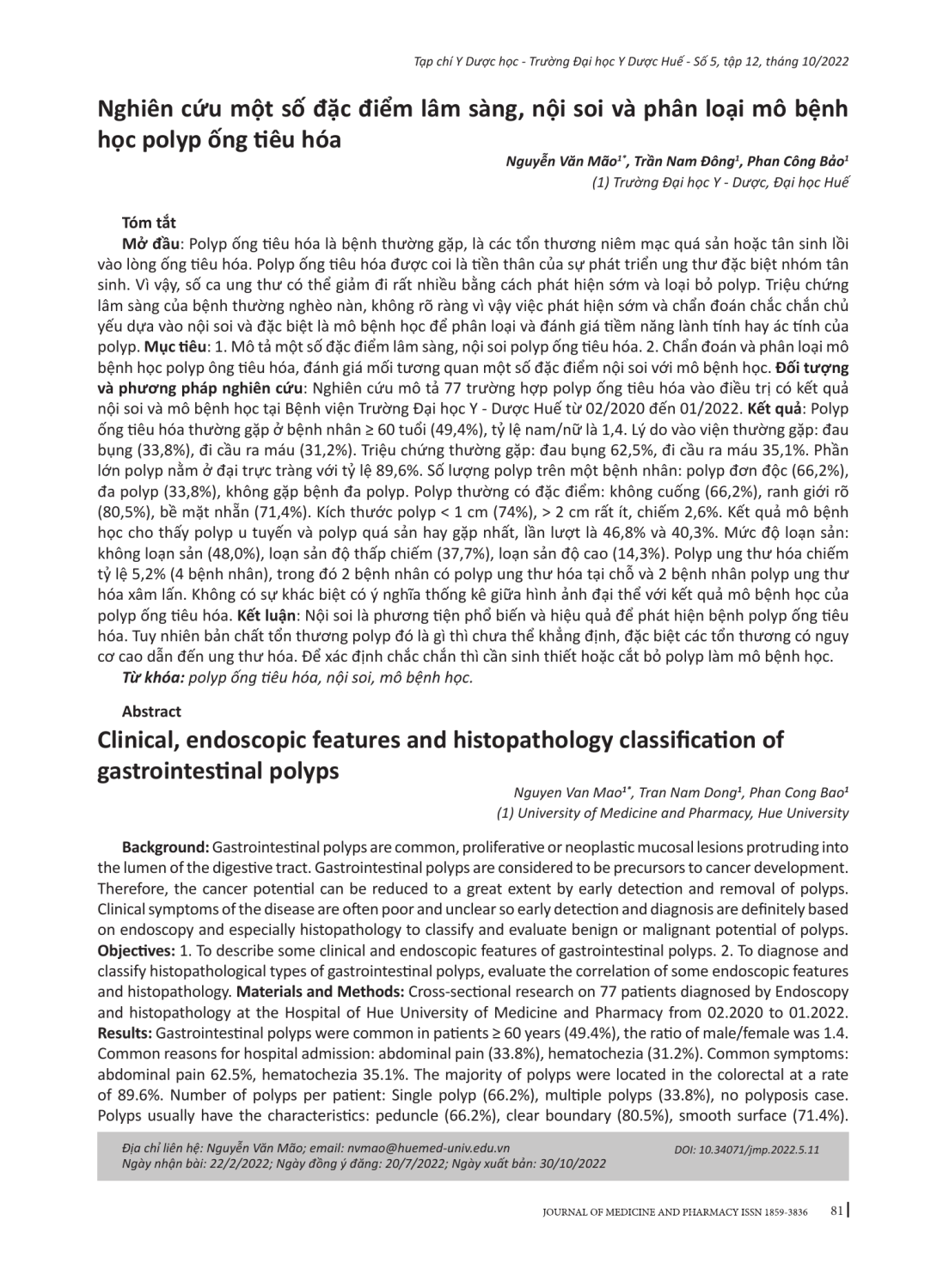
Mô tả một số đặc điểm lâm sàng, nội soi polyp ống tiêu hóa. Chẩn đoán và phân loại mô bệnh học polyp ông tiêu hóa, đánh giá mối tương quan một số đặc điểm nội soi với mô bệnh học. Đối tượng và phương pháp nghiên cứu: Nghiên cứu mô tả 77 trường hợp polyp ống tiêu hóa vào điều trị có kết quả nội soi và mô bệnh học tại Bệnh viện Trường Đại học Y - Dược Huế từ 02/2020 đến 01/2022. Kết quả: Polyp ống tiêu hóa thường gặp ở bệnh nhân ≥ 60 tuổi (49,4%), tỷ lệ nam/nữ là 1,4. Lý do vào viện thường gặp: đau bụng (33,8%), đi cầu ra máu (31,2%). Triệu chứng thường gặp: đau bụng 62,5%, đi cầu ra máu 35,1%. Phần lớn polyp nằm ở đại trực tràng với tỷ lệ 89,6%. Số lượng polyp trên một bệnh nhân: polyp đơn độc (66,2%), đa polyp (33,8%), không gặp bệnh đa polyp. Polyp thường có đặc điểm: không cuống (66,2%), ranh giới rõ (80,5%), bề mặt nhẵn (71,4%). Kích thước polyp < 1 cm (74%), > 2 cm rất ít, chiếm 2,6%. Kết quả mô bệnh học cho thấy polyp u tuyến và polyp quá sản hay gặp nhất, lần lượt là 46,8% và 40,3%. Mức độ loạn sản: không loạn sản (48,0%), loạn sản độ thấp chiếm (37,7%), loạn sản độ cao (14,3%). Polyp ung thư hóa chiếm tỷ lệ 5,2% (4 bệnh nhân), trong đó 2 bệnh nhân có polyp ung thư hóa tại chỗ và 2 bệnh nhân polyp ung thư hóa xâm lấn. Không có sự khác biệt có ý nghĩa thống kê giữa hình ảnh đại thể với kết quả mô bệnh học của polyp ống tiêu hóa. Kết luận: Nội soi là phương tiện phổ biến và hiệu quả để phát hiện bệnh polyp ống tiêu hóa. Tuy nhiên bản chất tổn thương polyp đó là gì thì chưa thể khẳng định, đặc biệt các tổn thương có nguy cơ cao dẫn đến ung thư hóa. Để xác định chắc chắn thì cần sinh thiết hoặc cắt bỏ polyp làm mô bệnh học.
: Gastrointestinal polyps are common, proliferative or neoplastic mucosal lesions protruding into the lumen of the digestive tract. Gastrointestinal polyps are considered to be precursors to cancer development. Therefore, the cancer potential can be reduced to a great extent by early detection and removal of polyps. Clinical symptoms of the disease are often poor and unclear so early detection and diagnosis are definitely based on endoscopy and especially histopathology to classify and evaluate benign or malignant potential of polyps. Objectives: 1. To describe some clinical and endoscopic features of gastrointestinal polyps. 2. To diagnose and classify histopathological types of gastrointestinal polyps, evaluate the correlation of some endoscopic features and histopathology. Materials and Methods: Cross-sectional research on 77 patients diagnosed by Endoscopy and histopathology at the Hospital of Hue University of Medicine and Pharmacy from 02.2020 to 01.2022. Results: Gastrointestinal polyps were common in patients ≥ 60 years (49.4%), the ratio of male/female was 1.4. Common reasons for hospital admission: abdominal pain (33.8%), hematochezia (31.2%). Common symptoms: abdominal pain 62.5%, hematochezia 35.1%. The majority of polyps were located in the colorectal at a rate of 89.6%. Number of polyps per patient: Single polyp (66.2%), multiple polyps (33.8%), no polyposis case. Polyps usually have the characteristics: peduncle (66.2%), clear boundary (80.5%), smooth surface (71.4%). Size of polyps: < 1 cm (74%), > 2 cm were very rare, accounting for 2.6%. Histopathological results showed that adenoma and hyperplasia polyps accounted for the highest proportion, respectively 46.8% and 40.3%. Level of dysplasia: no dysplasia (48%), low grade dysplasia (37.7%) and high grade dysplasia (14.3%). Adenocarcinoma polyps accounted for 5.2% (4 patients), of which 2 patients had carcinoma in situ and 2 patients with invasive adenocarcinoma. There was no statistically significant difference between the endoscopic features and the histopathological results. Conclusion: Endoscopy is a common and effective means to detect gastrointestinal polyps. However, the nature of these polyps has yet to be confirmed, especially the high risk ones of malignancy. For this reason, a biopsy or excision of the polyp is necessary for histopathology
- Đăng nhập để gửi ý kiến
